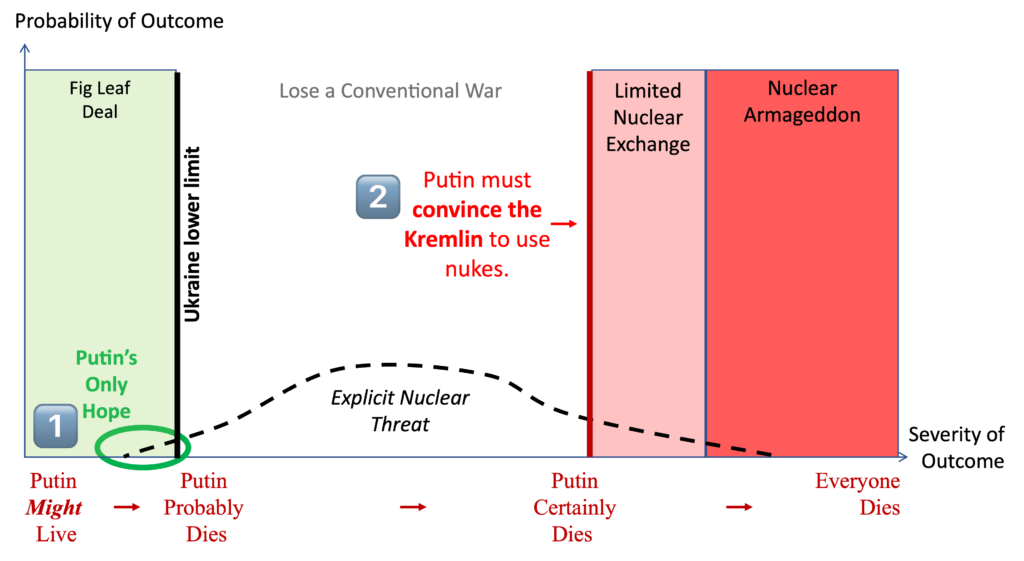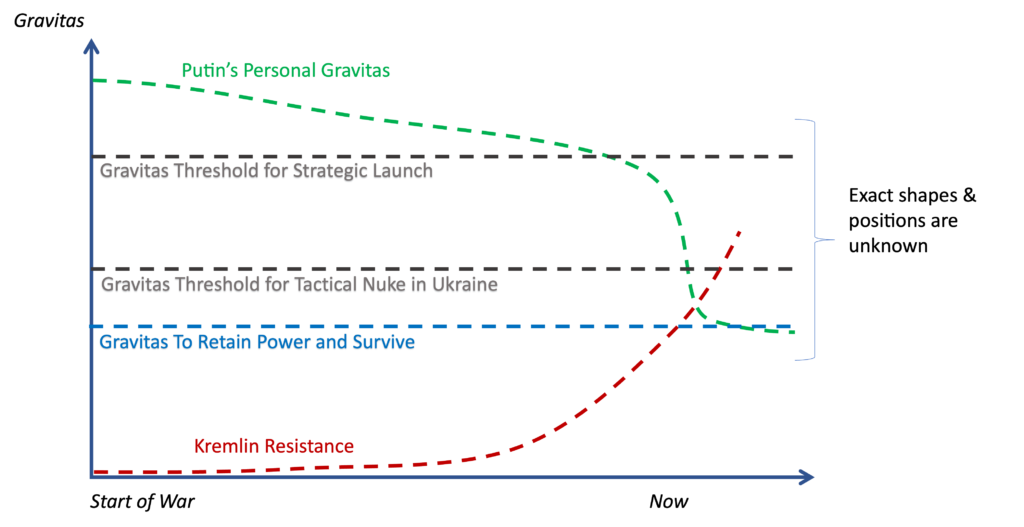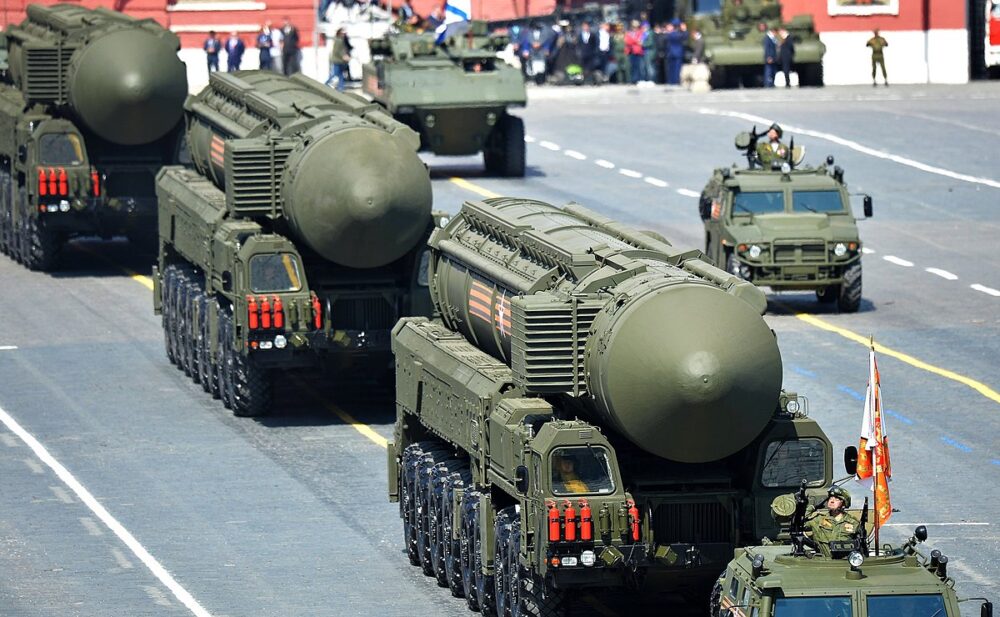Everyone is eager (arguably desperate) to understand how Vladimir Putin can be convinced to shut down his catastrophic invasion of Ukraine. Behind the urgency lies the fear that Putin may resort to nuclear weapons … initially as a threat, then with limited tactical use, but always with the risk of escalation to a global nuclear exchange. Michael de Adder’s cartoon captures our fear that Putin may start to feel doomed … and then his intentions are hard to predict, perhaps even by himself. What if he starts WWIII on impulse?
I recently found a Twitter thread that shed light on this question. Dr. Hein Goemans’ insights don’t offer a definitive answer, but they help to define the constraints that must inevitably frame Putin’s decision-making. I’ve organized my understanding of Dr. Goemans’ insights into a couple of diagrams. The first diagram shows the options that Putin faces if the conflict stays within the bounds of conventional war. The horizontal scale shows increasing severity of personal outcomes for Putin (and eventually for Russia and the World). Moving to the right means he losing the war in a more embarrassing way and his chances of survival diminish. Moving to the left means there may be an outcome that’s a bit more face-saving and survivable.

In the status quo, non-nuclear scenario, the probability distribution (dotted line) for Putin’s outcomes falls in the range where he loses the conventional war. From Dr. Goemans’ reading and from most reputable commentators I have read, Putin is unlikely to survive if he loses the conventional war badly. He might survive (barely) if he could negotiate a face-saving deal, but even that is uncertain. To further limit his options, Ukraine has made it crystal clear that it wants all of its territory and people back. That blocks Putin from pretty much any settlement that offers any decent chance of survival.
Dr. Goemans explains that, in this situation, Putin’s smart play is to make a credible threat to use tactical nuclear weapons. As Dr. Goemans explains it:
But Putin can pursue a “high variance” strategy: `flatten’ the probability distribution. He can pursue a strategy which increases the probability of a good enough outcome, which also increases the probability of a worse defeat for Russia.
Dr. Goemans’ Twitter Thread
In the next diagram, the direct threat of nuclear action “flattens and spreads” the distribution of possible outcomes. I divided the continuum into four ranges. On the left, there is a small region where Putin’s threat somehow bullies the world and Ukraine into a negotiated settlement (#1) that saves enough face that he can survive and cling to power. It’s a lottery-grade longshot, but as you look right, the outcomes are progressively worse. If he loses the war badly, he’s almost certainly deposed and dead. Several world leaders have publicly opined that if he launches nukes, he is dead for sure. If the nukes go global, we all die.

For Putin, the appeal of making a credible nuclear threat is that he has nothing to lose. He can only die once. If there is even a small chance that a threat will give him a face-saving exit, it’s a chance worth taking. In Dr. Goemans’ view, that means that Putin is very likely to issue the threat. It shouldn’t come as a surprise if he does. It also doesn’t mean that the threat will turn into action.
Putin’s problem is that, once the threat is made, there’s no going back. If he doesn’t get his deal, his next move is to back down or try to launch the nukes. If he backs down, that will compound his weakness and worsen his prospects. If he tries to launch, the Russian power structure may or may not block him (#2). By all accounts, Putin cannot just “push a button” to launch nukes, tactical or otherwise. He needs action from several levels of the Russian military to light the rocket. What if they say no? Now he has made the threat and can’t deliver. If he has to act, he is in a lose-lose position. If his order is followed, the World’s reaction will doom him. If the order is ignored, he will be likely be deposed for having tried to issue it.
Still, if he feels he has nothing to lose, he will make the threat and hope for the best.
That gets us to the next question. What can we deduce about the likelihood that the Russian military might say no (and/or remove Putin for asking)? Here, I abandon Dr. Goemans’ guidance and toddle off on my own. The following diagram is my model for how Russia’s (not just Putin’s) decision-making might play out. I kept it simple with a few variables:
- Putin’s personal gravitas – Call it what you will: clout, juice, power, authority, charisma, or something else. Leaders need more than just “chain of command” authority to get really hard things done. They need leadership credibility. Putin has built his gravitas over decades, to the point that he is called “the Supreme” in Russian social media.
- Minimum gravitas thresholds for different types of order – I’m assuming that a leader must meet a minimum threshold of clout or gravitas to get people to follow a difficult order. In this case, there are probably at least three levels to consider:
- A basic level required for Putin to survive in power. He has had that for decades.
- A higher bar for using tactical nukes against a non-nuclear former territory.
- A very high bar for launching strategic nukes … i.e., ordering Russia to commit suicide.
- Overt Kremlin resistance to pre-empt Putin’s authority – Totally apart from Putin’s political gravitas, we must account for the possibility that individuals or groups in the Russian system may act directly against him. This resistance doesn’t need to be chain of command or broad based. An assassin or small palace coup would do fine.
This following diagram assembles my thoughts about these variables, especially how they may be changing over time. It’s not to scale because I can barely even guess at the position or shape of these factors.

However, a few assumptions seem reasonable. First, it seems likely that Putin’s personal gravitas (green line) is falling … and falling faster over time. Embarrassment tends to do that to gravitas and Ukraine has embarrassed him rather frequently of late. Second, there are increasing reports of dissatisfaction with Putin in higher Russian circles (here, here, here, and here) so the odds of direct resistance (assassination, forced retirement, or coup) should be rising. Third, there’s a time element to ordering a nuclear strike. Both US and Russian “just push the button” protocols assume a scenario where an enemy strike is imminent. However, the US and NATO have carefully refrained from any action that would signal launch preparation. Action by Putin will be unprovoked, planned and premeditated and he should encounter more headwinds if he tries to make it unilaterally.
Unfortunately, casual outside observers like me can’t tell where the various gravitas levels are now, or if they are likely to cross anytime soon. We don’t even know if he ever had enough clout to launch nukes against Ukraine in the first place and we won’t know when or if he has lost enough to be blocked by the Russian system. We can only hope that the threshold is high and that Putin’s brand has fallen enough that he can’t surpass it. Finally, we don’t know what nefarious schemes are being hatched around the Kremlin as we speak.
So where do we look for insight and reassurance? FWIW, I rely on two indicators.
Number 1: The Experts Aren’t Scared
It seems certain that intelligence services around the World are scouring their sources to pin down these very factors. Therefore, it’s meaningful that the most knowledgeable countries, Russia’s immediate neighbors on the front line of any nuclear event, have collectively issued the following statement.
These countries are highlighted in light orange on the map. They were all internal regions or vassal states of the USSR as little as 30 years ago. Consequently, there was a strong intermingling of political, technical, intelligence and military personnel … as well as families and friends. If anyone has sources deep in the Kremlin, it will be the intelligence services in this group. Presumably, their governments are acting on what they know.

In their joint statement they ask that NATO and the West support Ukraine’s efforts to regain ALL of its land with as much military help as they can give, as quickly as they can give it. There’s no hint of caution or fear in their demand. To me, that’s encouraging, coming from Russia-savvy countries on the firing line. Their position is echoed by the leaders of the G7 countries, most of whom have decent intelligence services (e.g., CIA & MI6). Like the front line nations, their statement displays no sense of fear or restraint.
A global consensus on matters as perilous as this are pretty rare. To see this level of agreement among governments that are this diverse, this close to the front line, and this knowledgeable, is reassuring.
Number 2: Putin Had to Hold a Referendum
Putin’s worked hard to conduct a sham referendum to annex the Ukranian regions that Russia partially occupies. Russian commentators connected this to the fact that Russian nuclear doctrine only authorizes the use of nuclear weapons to preserve Russian territorial integrity. In other words, Putin needed a sham referendum to create a basis in Russian law to launch a tactical nuclear attack on Ukraine. That strongly suggests that his personal gravitas is insufficient. He had to endure a complex charade to build the necessary political cover in Russia.
Sparse as they are, I believe these bits of evidence support the following tactical recommendations:
- Keep Putin Distracted and Play for Time .
The longer the war lasts, the more embarrassed and weaker he will become. So continue to throw time-consuming curve balls at him. Dangle teasing negotiations. Introduce a surprising new type of sanction every so often. The idea is to draw his attention to side problems for at least a few days. People must usually work themselves up to commit suicide. Keep stealing Putin’s prep time with distractions. I used to ridicule Macron’s phone calls and Erdogan’s offers for negotiations. On reflection, maybe they were the type of time-consuming distractions that can help. However, I still find it hard to credit Elon Musk. - Support Ukraine to the Max.
Ukraine is weakening Putin by embarrassing him on the battlefield. Accelerate the military support to Ukraine so they can make him look silly even faster. We want Putin to be reeling from a new setback every week. This will keep him off balance and constantly having to shore up his military position and political base. It will hasten the end of the war in its own right and it will allow time for Putin to be overthrown or become too weak to use the nukes. - Play to the Broader Russian Audience.
Early in the war, no one in Russia was listening to the World’s outcries. However, that seems to be slowly changing. If you haven’t followed @JuliaDavis on Twitter, I highly recommend doing so. She tracks the daily rantings of Russia’s official talk shows (i.e., Fox News for Russians). The rhetoric has been slowly shifting from bellicose chest-thumping, to angry concern, to rising despair. Mostly that comes from failures on the battlefield and Russia’s disastrous partial mobilization. Yet, we may finally be approaching the point where messages questioning Putin’s decisions appear in public media. That can only acclerate Putin’s loss of authority.
When I put all of this together, it boils down to three predictions and recommendations:
- Unless deposed, Putin eventually will threaten tactical nukes against Ukraine. No choice.
- The threat will not prove that he has the ability to launch. He probably doesn’t.
- The more Ukraine and the West can deliver surprises and shocks to keep him off balance, the more rapidly he will lose the gravitas needed to actually escalate.
If this is the game plan, I must give kudos to most of the world’s leaders. Zelensky and Biden of course, but many others are playing key roles. It appears to be a team effort.
A Q-inspired Postscript
Every dry analytical paper needs a good Q conspiracy. I can imagine that the actions of Macron and Scholz and Erdogan might be calculated, but what about the wacky tankies? How do we assess Tucker, Tulsi, MTG, Elon, Steven Segal and (gasp!) Trump? What if “pro-Putin” Republicans are secretly working with the Deep State? I can see how their actions might fit.
Imagine Putin in his bunker watching Russian TV talk shows. The programs often showcase Tucker, Trump, MTG, Tulsi and Elon hyperventilating about how badly Putin is being treated. There is a strong implication that, if Republicans win in November, they will radically change US policy. Sure, Putin is contemplating the nuclear option, but maybe he should wait to see how the next elections turn out? The crew keeps stringing him along with one forelorn hope after another. All with the goal of keeping him paralyzed until the Kremlin can take him down.
Of course, it’s all the old fakeroo. Trump and Tucker and Tulsi meet weekly with the CIA and monthly with Biden and Zelensky to plan their next moves. The gambits are always juicy enough to hold Putin’s interest, but never real enough to slow down Ukraine’s progress in battle. When the war is over and Putin is deposed, they will all go on 60 Minutes and reveal this amazing deception.
OK. OK. I’ll go take my meds now.

